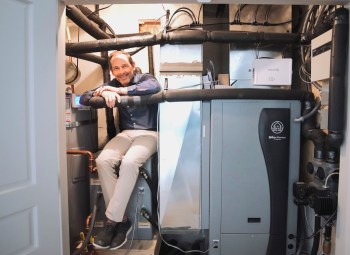When we walk into Republican Congressman John Curtis' new home in Provo, Utah, he jokes, "Don't be shocked — this is a climate-friendly home."
We've arrived for a house tour, and he's almost giddy with excitement to show off the home features that, he says, are saving his family thousands of dollars a year while showcasing the potential of clean home technology.
The conservative climate leader gave The Cool Down an exclusive look at his tricked-out new house, including the features that often leave him impressed at his own monthly savings.
"What I love to brag about is my utility bill," Curtis told us.
💡Save thousands with a heat pump
A heat pump can save you thousands of dollars in heating and cooling costs — but first you have to find the right installer at the right price.
Use EnergySage's free tool today to find local options, compare prices, and see how much you can save.

The Cool Down may receive a commission on signups made through links on this page, but we only promote partners we vet and believe in. For more cool tips like this one, check out our solutions list here.
Geothermal Heat Pump
For heating and cooling his home, Rep. Curtis landed on a geothermal, or "ground source," heat pump.
To heat or cool the home, liquid runs through pipes that are typically laid 6 to 7 feet underground and then goes through a heat pump exchange. Curtis says the device is saving him up to 70% on HVAC costs compared to a normal system and comes with a 30% federal tax credit. And what about those rumors that heat pumps don't work in cold climates like in Utah?
"I can just tell you that my geothermal system did fantastic in a very cold winter," Curtis said.
LED Lightbulbs
The family installed LED lightbulbs throughout the house, which emit less heat, use less energy, and reduce electricity costs.
"They're inexpensive and a great place to start if you're wondering what you can do to be friendly to the environment," Curtis said.
TCD x JOHN CURTIS
Solar Panels
With 30 solar panels on his roof, Rep. Curtis says he's saving $300-$400 a month on his utility bill.
"This is an easy investment," he told us. "Because over time, they pay off over and over again."
Insulation
"I think insulation is probably one of the most overlooked features of a home in making it not only energy efficient but saving on utility bills," Curtis told us.
Curtis "went big" on insulation, with 18 inches of insulation on his attic floor and 2 inches of foam spray on the attic walls and beneath the basement floor. Homeowners can get a 30% tax credit for insulation upgrades, and utility companies will often do a free or low-cost energy audit to help assess whether you need better insulation.

Low-Flow Toilets
By installing low-flow toilets, Curtis conserves water and saves on his water bill. They're often no more expensive than regular toilets and can help you save up to 13,000 gallons of water and more than $140 every year.
Bidets
Although he was "a skeptic at first," Curtis installed a bidet on his toilet.
"It's actually really nice," he said. "The seat warms up, and we hardly ever use a roll of toilet paper."
Bidets can save between $180 and $350 a year on toilet paper and use only an eighth of a gallon per flush versus 37 gallons of water needed to produce toilet paper.
Freeze Dryer
Curtis and his wife love their Harvest Right Freeze Drier, which freeze-dries foods for up to 25 years.
Scraps and leftovers — from fruits and veggies to meat, eggs, ice cream, and even Oreos — go in the drier and then are stored in vacuum-sealed bags in their basement to enjoy for literally years to come. While it's a significant initial investment, Americans waste an estimated $1,500 a year on food waste, which also creates toxic methane gas. Go deeper into Curtis' food hack here.
"This is a real way to actually save money and cut down on that food bill," the congressman said.

Drought-Tolerant Landscaping
Curtis has six children and a 16th grandchild on the way, so it was important for him to have a great, big-family-sized yard. They mapped out the size of a grass volleyball court and used rock landscapes to conserve water, which is incredibly important given the ongoing drought in Utah.
As the Republican Representative from the 3rd District in Utah and the founder of the Conservative Climate Caucus, which counts about a third of House Republicans as members, it was important to Curtis that his new home shows how he practices what he preaches. Read here for more on how Curtis is busting conservative climate myths.
"I wanted to make sure that in my own life, I was doing what I could to be friendly to the climate," he told us. "When I speak to my friends, conservatives and fellow Republicans, a lot of times they don't automatically associate the value that comes with making climate-friendly changes. Even if somebody's not doing these things for the impact on the environment, the financial sense is what really should capture all of us."
Other than some additional upfront costs, which can be offset by tax credits and creative financing, Curtis told us he sees no sacrifices involved with adding climate-friendly features.
"What surprises me most about living in a climate-friendly home is day to day, it's really no different than any other home," he said. "Except that there are certain features that make the house more comfortable. All these small things, the more insulation, the 2 inches under the floor and things like that, they're small, but they all add up."
But as we wrap the tour, Curtis is quick to point out that he's not perfect.
"One of my worries in talking about this is, it's obvious I could have done more," he says. "For those of you who are going to be mad, you're right. And for those of you who think, 'I could never do this,' you can."
Join our free newsletter for easy tips to save more, waste less, and help yourself while helping the planet.












